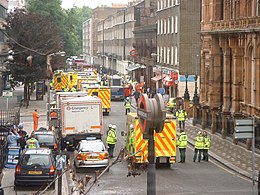7 July 2005 London bombings
| 7 July 2005 London bombings | |
|---|---|

Emergency services at Russell Square tube station on 7 July 2005
|
|
| Location | London, United Kingdom |
| Coordinates | 51°30′18″N 0°04′43″W / 51.504872°N 0.07857°WCoordinates: 51°30′18″N 0°04′43″W / 51.504872°N 0.07857°W |
| Date | 7 July 2005 08:49 – 09:47 BST (UTC+01:00) |
| Target | General public aboard London Underground trains and a bus in central London |
|
Attack type
|
Mass murder, suicide bombings, terrorism |
| Weapons | TATP |
| Deaths | 56 (including the 4 perpetrators) |
|
Non-fatal injuries
|
784 |
| Perpetrators |
Hasib Hussain Mohammad Sidique Khan Germaine Lindsay Shehzad Tanweer |
|
The 7 July 2005 London bombings, sometimes referred to as 7/7, were a series of coordinated terrorist suicide bomb attacks in central London which targeted civilians using the public transport system during the rush hour.
On the morning of Thursday, 7 July 2005, four Islamist extremists separately detonated three bombs in quick succession aboard London Underground trains across the city, and later, a fourth on a double-decker bus in . 52 people were killed and over 700 more were injured in the attacks, making it Britain's worst terrorist incident since the 1988 bombing of Pan Am Flight 103 over Lockerbie, Scotland, as well as the country's first ever Islamist suicide attack.
The explosions were caused by homemade organic peroxide-based devices packed into backpacks. The bombings were followed two weeks later by a series of attempted attacks that failed to cause injury or damage. The 7 July attacks occurred the day after London had won its bid to host the 2012 Olympic Games, which had highlighted the city's multicultural reputation.
Main articles
Timeline of the 2005 London bombings
7 July 2005 London bombings
21 July 2005 London bombings
Jean Charles de Menezes
Reactions to the 2005 London bombings
21 July 2005 London bombings trial
7 July bombers
Mohammad Sidique Khan · Shehzad Tanweer
Germaine Lindsay · Hasib Hussain
...
Wikipedia
